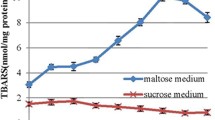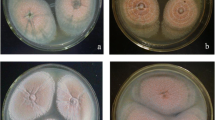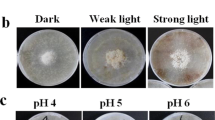Abstract
Melanin pigments constituted 13.9% (W/W) of sclerotial walls ofSclerotium rolfsii. The lipid and ash contents in sclerotial walls were twice those in hyphal walls of the fungus. Progress in culture age and maturation of sclerotia were always accompanied by increased levels of lipid peroxidation products and melanin. Lipid peroxidation and melanin formation may thus proceed in parallel during sclerotial biogenesis and maturation. Both these processes are strongly affected by Fe2+ and by antioxidant vitamins (ascorbic acid), microelements (selenium) and mercapto compounds (glutathione). Myceliogenic germination and lytic activityvia melanin production can thus be affected by (anti)oxidants that could potentially be used for controlling sclerotia-producing fungi without using traditional toxic fungicides.
Similar content being viewed by others
References
Antibus R.K.: Formation and structure of sclerotia and sclerotiumspecific proteins inHygrophoropsis aurantica.Mycologia81, 905–913 (1989).
Ballesta J.P.G., Alexander M.: Resistance ofZygorhynchus species to lysis.J. Bacteriol.106, 938–945 (1971).
Bartlett R.J.: Phosphorus assay in column chromatography.J. Biol. Chem.234, 466–471 (1959).
Bartnichi-Garcia S., Reyes G.: Chemistry of spore wall differentiation inMucor rouxii.Arch. Biochem. Biophys.108, 125–133 (1964).
Bull A.T.: Inhibition of polysaccharases by melanin: enzyme inhibition in relation to mycolysis.Arch. Biochem. Biophys.137, 345–356 (1970).
Cantarow A., Schepartz B.:Biochemistry, 3rd ed., p. 938. W.B. Saunders Co., USA 1962.
Chet I., Henis Y., Michell R.: The morphogenetic effect of sulfur-containing amino acids, glutathione and iodoacetic acid onSclerotium rolfsiiSacc.J. Gen. Microbiol.45, 451–546 (1966).
Coley-Smith J.R., Cooke C.R.: Survival and germination of fungal sclerotia.Ann. Rev. Phytopathol.9, 65–92 (1971).
Chu S.B., Alexander M.: Resistance and susceptibility of fungal spores to lysis.Trans.Brit. Mycol. Soc.58, 489–497 (1972).
Christias C.: Specific inhibition of sclerotium formation by 2-mercaptoethanol and related sulfhydryl compounds inSclerotium rolfsii.Can. J. Microbiol.21, 1541–1547 (1975).
Ellis D.H., Griffiths D.A.: Melanin deposition in the hyphae of a species ofPhomopsis.Can. J. Microbiol.21, 422–452 (1975).
Folch J., Lee S.M., Sloane-Stanley H.G.: A simple method for the isolation and purification of total lipids from animal tissues.J. Biol. Chem.226, 497–509 (1957).
Georgiou C.D.: Lipid peroxidation inSclerotium rolfsii: a new look into the mechanism of sclerotial biogenesis in fungi.Mycol. Res.101, 460–464 (1997).
Griffin D.M., Nair G.N.: Growth ofSclerotium rolfsii at different concentrations of oxygen and carbon dioxide.J. Exp. Bot.19, 812–816 (1968).
Hansberg W., Aguirre J.: Hyperoxidant states cause microbial cell differentiation by cell isolation from dioxygen.J. Theoret. Biol.142, 201–221 (1990).
Hansberg W., De Groot H., Sies H.: Reactive oxygen species associated with cell differentiation inNeurospora crassa.Free Radical Biol. Med.14, 287–293 (1993).
Johm H.E.: A nutritional study of the fungusSclerotium rolfsii. MSc Thesis. A and M College of Texas (1943).
Kuo M.J., Alexander M.: Inhibition of the lysis of fungi by melanins.J. Bact.94, 624–629 (1967).
Loewus F.A.: Improvement in the anthrone method for determination of carbohydrates.Analyt. Chem.24, 219 (1952).
Loverkovich L., Loverkovich H., Stahmann M.A.: The importance of peroxidase in the wildfire disease.Phyto-Pathology58, 193–198 (1968).
Mahadevan P.R., Tatum E.L.: Relationship of the major constituents of theNeurospora crassa cell wall to wild type and colonial morphology.J. Bacteriol.90, 1073–1081 (1965).
Naguib M.J.: Effect of sevin on carbohydrate and nitrogen metabolism during the germination of cotton seed.J. Exp. Biol.2, 117–122 (1964).
Nicolaus R.A., Piattelli M., Fattorusso E.: The structure of melanins and melanogenesis. IV. On some natural melanins.Tetrahedron20, 1163–1172 (1964).
Potgieter H.J., Alexander M.: Susceptibility and resistance of several fungi to microbial lysis.J. Bacteriol.91, 1526–1532 (1965).
Quinlan J.G., Halliwell B., Moorhouse C.P., Cutteridge C.M.J.: Action of lead(II) and aluminum(III) ions in iron-stimulated lipid peroxidation in liposomes, erythrocytes and rat liver microsomal fractions.Biochim. Biophys. Acta962, 196–200 (1988).
Russell J.A.: Note on the colorimetric determination of amino nitrogen.J. Biol. Chem.156, 467 (1944).
Toledo I., Hansberg W.: Protein oxidation related to morphogensis inNeurospora crassa.J. Exper. Mycol.14, 184–189 (1990).
Ward G.M., Johston F.B.: Chemical methods of plant analysis.Can. Dept. Agr. Publ. no. 1064 (1960).
Willetts H.J.: The survival of fungal sclerotia under adverse environmental conditions.Biol. Rev.49, 387–407 (1971).
Author information
Authors and Affiliations
Rights and permissions
About this article
Cite this article
Ellil, A.H.A.A. Sclerotial development, melanin production and lipid peroxidation bySclerotium rolfsii . Folia Microbiol 44, 181–186 (1999). https://doi.org/10.1007/BF02816239
Received:
Revised:
Issue Date:
DOI: https://doi.org/10.1007/BF02816239




